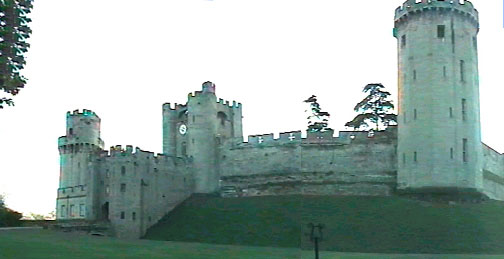
WARWICK CASTLE

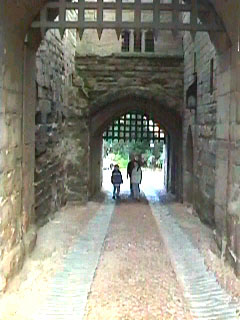 |
The first wooden fortress built upon this hill was in
1068. It was slowly remodeled with stone and by the 14th century
was a towering medieval stronghold. This is a beautifully preserved castle.
The furnishings are all authentic of the period.
The entry way is everything you'd expect. It's easy to imagine Richard of Glouchester, (King Richard III), and his knights riding in at dusk; candle lit on a foggy evening, through this entry, with the sound of the horse's hoofs and the armor echoing out of the entry walls. |
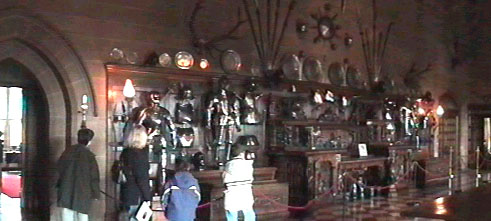
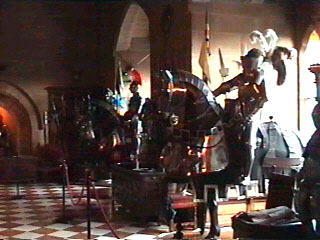 |
The Great Hall houses a grand display of armor and weaponry. The oldest suit of armor is of the 15th century. The horse is fitted with 16th century German Armor and the knight is dressed in heavy Italian jousting armor. |
| With the advent of guns and cannons, castles were no longer a good protective fortress. Castles transitioned from a protective structure to luxury mansion. The second floor is 19th century woodwork and furnishings. Original portraits of many dukes, earls, kings and queens fill the rooms and hallways. | 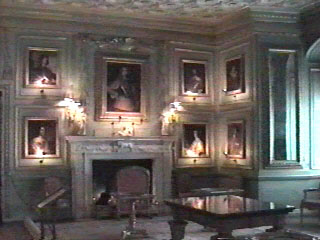 |
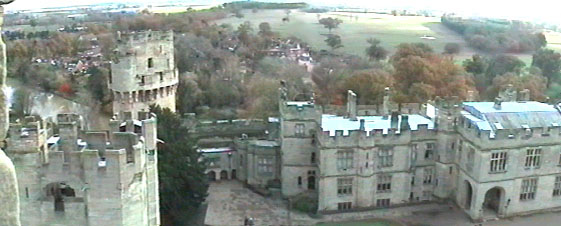
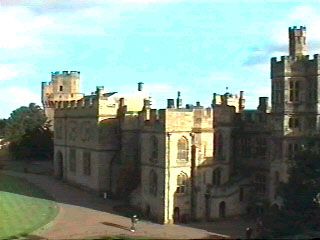 |
Guy tower is the largest and tallest, standing 39 meters (128 feet) tall. It can be seen in the picture at the top of this page. Towers were used by archers to fight off attackers. The history of Warwick Castle reads like the history of England itself. The castle has been under the ownership or custodianship of Earls, Dukes and Kings such as Richard III and Henry VIII. While tempting to convey the full history, once again, I'll stop short of writing an entire book. |
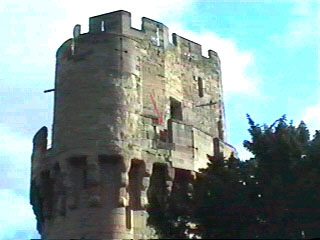 |
For the scale of these towers, take a look at the boys on Caesar's Tower. They are in the opening beneath the faint red arrow. This castle is also complete with a real dungeon and torture chamber. Ghost Tower, not seen in any of these pictures, is said to be haunted with the spirit of Sir Fulke Greville, murdered in 1628 by his manservant for being left out of his will. |
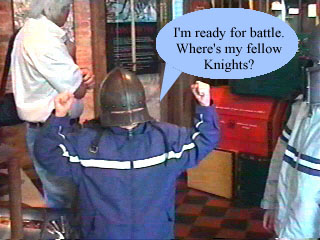 |
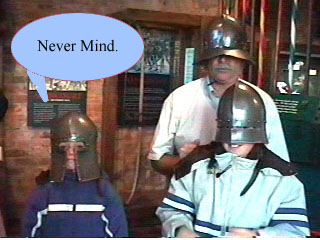 |
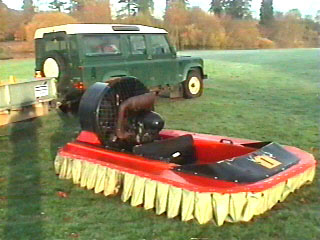 |
Stonehenge is a bit of a drive, so we started out early. While driving out of Walton Hall, (our home for the week), we came upon this hover craft. A conference group at Walton Hall had hired "Action Adventures, Ltd." for a little midday activity which would include 4-wheel ATVs, hover craft racing on the lawn, clay pigeon shooting and archery. Working for Boeing, I don't remember any conferences like this. |
| Ten miles out and the carrigeway becomes congested. We had stumbled upon market day in Morton-in-Marsh. Every Tuesday vendors set up an open market in the middle of the main street. Cars parked everywhere and busses unloaded along the side. The market runs about three blocks with produce, meats, clothing, household good and a few electronics. Morton-in-Marsh is about as quaint as quaint can get. It's just a few blocks long with the church in this photo being the largest building. | 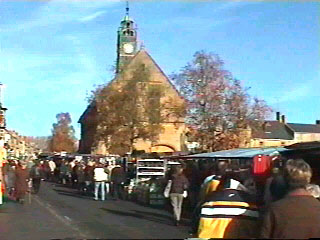 |
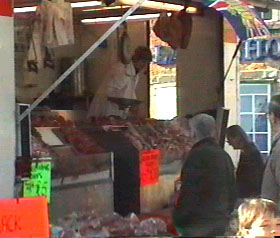 |
Everything was priced very low. This butcher was working out of a trailer. To drum up business he'd throw several lamb shanks on the scale and shout, "four lamb shanks for 10 quid -- just ten quid, take it all -- Just 10 quid -- I throw on two more shanks; six lamb shanks for 10 quid, no deal better . . . . " (A quid turns out to be another name for a pound. A pound is equal to $1.41). |
| Drury's is a meat market in town that's been in business since 1817, probably in the same building. That's about 14 years after the Lewis and Clark expedition. That's incredible! | 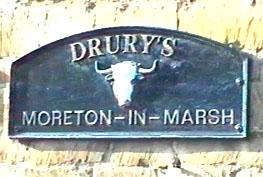 |
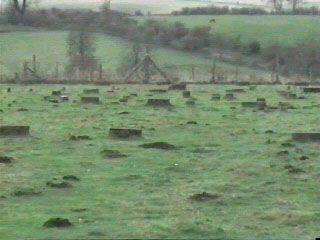
|
Five thousand years ago a timber shrine was built on this hill. Rebuilt and enlarged several times during the following thousand years, the old shrine was finally replaced by a double stone circle. The circle was linked by an avenue of stones to a new temple in Avebury, about three miles from this site. |
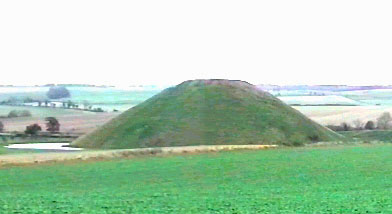
|
Between the Sanctuary and Avebury is Salbury Hill. I had heard of Avebury before and since it was on the way to Stonehenge I wanted to stop and see it, (though I suspected there wasn't much to see). |
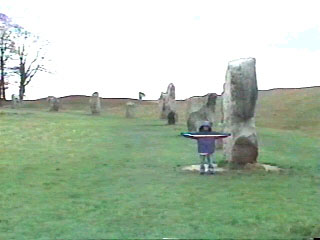
|
Avebury was another stop. I didn't know anything
about it other than it's also a popular location for many of the mysterious
crop circles. I had also heard about the mathematical relationship
to other prehistoric sites around the world.
I was surprised to learn there is a stone circle here too. There are actually many stone circles and other prehistoric sites throughout Great Britain. I'd like to visit the stone circle site recently uncovered near Miami when we get there this winter. Maybe we'll have to go to Easter Island next to see the large stone structures there. |
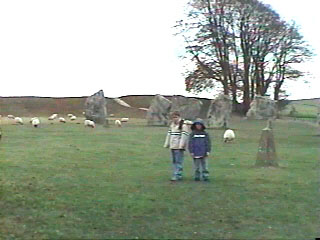 |
Today these stones are just standing in the middle of a field full of sheep. Several smaller stone monuments have been placed where large stones used to stand, (probably recycled into the many stone houses in the immediate area). |
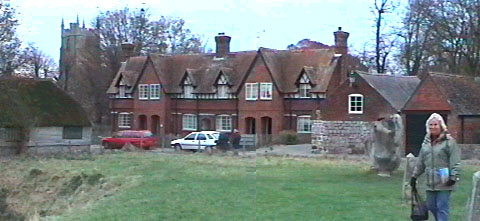 |
This picture is incredible. It includes a traditional house of England, a fabulous stone abby in the background, (that's probably made of stones missing from the circle), a small English road in the town of Avebury, which coexists with the large stone circle, part of the moat that encircles the stone circle, a traditional thatched roof building, and last but not least, a beautiful blond. |
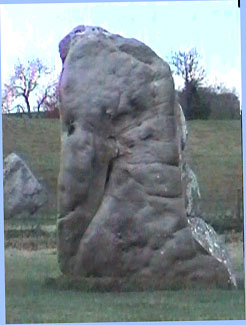 |
Here's an interesting stone in the circle. I saw
a newspaper clipping about it in the visitor center. It caught my
eye because of yet another connection to Egypt. In 1998 a local man
visited the Great Pyramids. Upon his return, he noticed that this
stone formed half of the face of a Sphinx. It also turns out to be
aligned in such a way that, as we look at it here, we are looking directly
toward the Giza Plateau.
So I took the stone and added it's mirror image. |
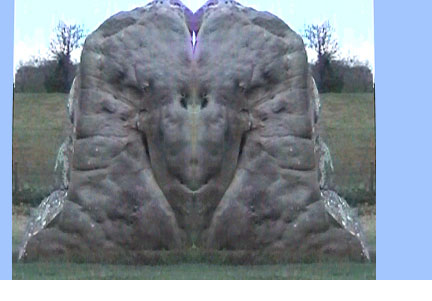 |
While interesting, I'm not sure what to make of this.
In real life it was hard to see the half face. If it was a face,
it should have eroded. But how much? Could a stone erode into
this shape? Could erosion cause the horizontal cuts?
I think there's more to the story to explain all of the large stone structures around the world than what current theory provides. However, it's difficult to make a decision on this one. |
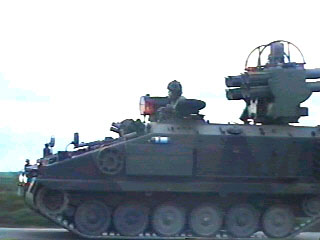 |
While driving to Stonehenge, we came across several "Tank Crossing" signs. We saw this tank rolling down the street from the Stonehenge parking lot. It appears as if the tank training ground simply cuts through sheep fields. I suppose with a country that's smaller than the state of California, you need to share the land with sheep, wheat and tanks. |

STONEHENGE
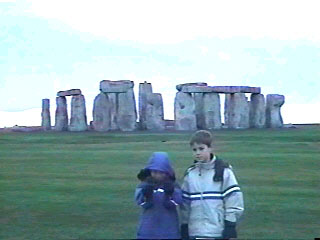 |
Here it sits. What an incredible mystery. Just sitting here out in the middle of green rolling hills. Sitting just as it has century after century. |
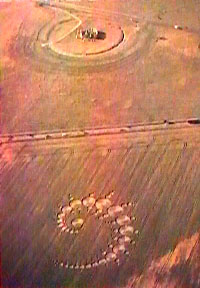 |
This picture shows Stonehenge and a giant crop circle across the highway. I followed the annual crop circle formations for several years but have not paid attention to them for the last two or three years The chap at the visitor center said that they continue to get more of them every year and that they continue to become more elaborate. He said that there are some obvious hoax circles but there are still the ones with characteristics that are mysterious to explain. He also pointed out that this is not a new phenomena. This has been going on for centuries, even on grass and ice, but only recently have become of interest. |
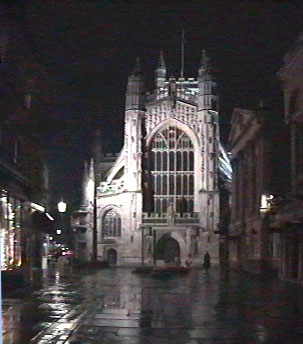 |
We also planned on a stop at the city of Bath. It was late, 6:00 p.m. and most attractions, stores, and even restaurants were closed. Bath is a town built by the Romans when they came here in the 6th century. The Abby was beautifully lit and we walked past the old Roman bath houses. At quick dinner and then we headed for home. |
|
|
|
|
Next Adventure (Stratford-upon-Avon) |
ã
copyright Nodland 1999-2020